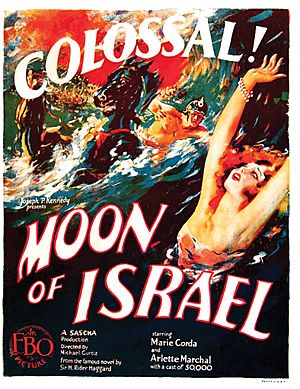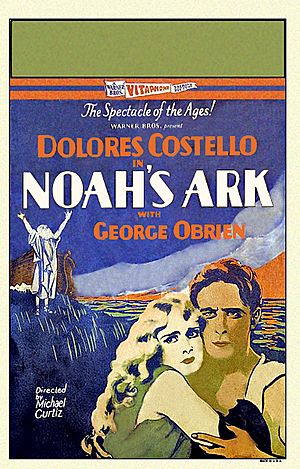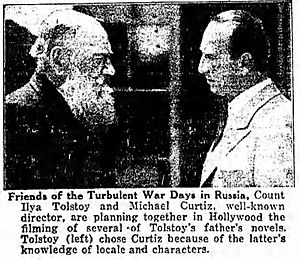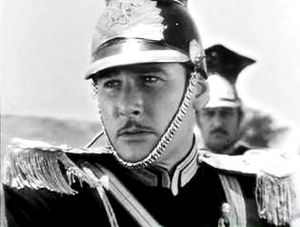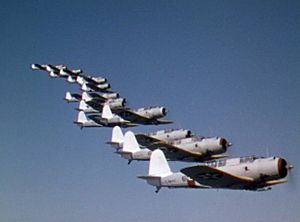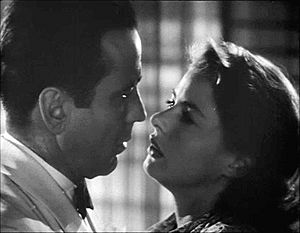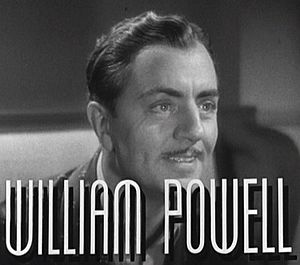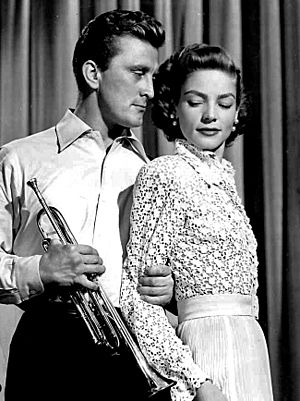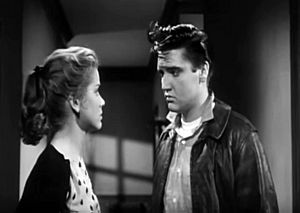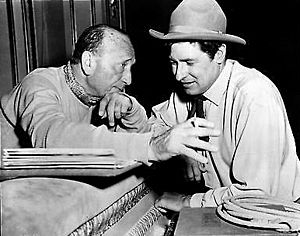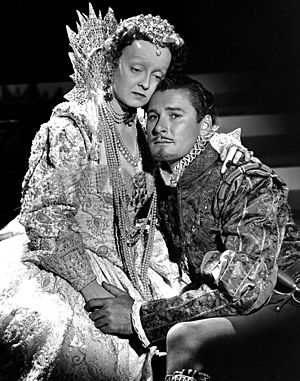Michael Curtiz facts for kids
Quick facts for kids
Michael Curtiz
|
|
|---|---|
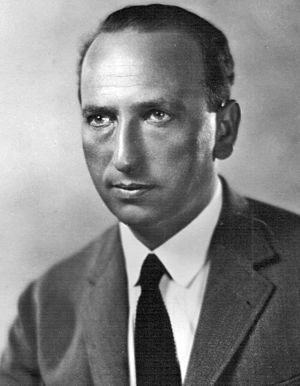
Curtiz c. 1920s
|
|
| Born |
Manó Kaminer
December 24, 1886 |
| Died | April 10, 1962 (aged 75) Los Angeles, California, U.S.
|
| Other names | Mike Curtiz |
| Citizenship | Hungary (1886-1933) United States (after 1933) |
| Occupation | Film director |
| Years active | 1912–1961 |
| Spouse(s) |
Lucy Doraine
(m. 1918; div. 1923)Bess Meredyth
(m. 1929) |
| Children | 2 |
Michael Curtiz (born Manó Kaminer; later Mihály Kertész; December 24, 1886 – April 10, 1962) was a famous Hungarian-American film director. He made more movies than almost anyone else in history. He directed many classic films, from the early silent movie days to Hollywood's "Golden Age." This was a time when big movie studios made most films.
Curtiz was already a well-known director in Europe. In 1926, when he was 39, Warner Bros. invited him to Hollywood. He had already directed 64 films in Europe. He quickly helped Warner Bros. become a very fast-growing movie studio. During his time in Hollywood, he directed 102 films, mostly for Warner Bros. He helped ten actors get Oscar nominations. James Cagney and Joan Crawford won their only Academy Awards because of his direction. He also helped Doris Day and John Garfield start their movie careers. He made stars out of Errol Flynn, Olivia de Havilland, and Bette Davis. Curtiz himself was nominated for an Oscar five times and won twice. He won for Best Short Subject for Sons of Liberty and for Best Director for Casablanca.
Curtiz brought a special visual style to Hollywood. He used artistic lighting, smooth camera movements, high crane shots, and unusual camera angles. He was very good at directing all kinds of movies. These included dramas, comedies, love stories, musicals, war films, and Westerns. He always focused on the human side of every story. He believed that the "human and basic problems of real people" were the most important part of any good drama.
During the filming of The Charge of the Light Brigade, an accident happened where 25 horses died. This led to a big argument between Curtiz and the movie's star, Errol Flynn. Because of this, the U.S. Congress and the ASPCA (a group that protects animals) made new rules. These rules help prevent cruelty to animals on movie sets.
Curtiz helped make swashbuckler films popular. These are adventure movies with sword fights and daring heroes. Examples include Captain Blood (1935) and The Adventures of Robin Hood (1938). He also directed many other classic dramas. Some of these are Angels with Dirty Faces (1938), The Sea Wolf (1941), Casablanca (1942), and Mildred Pierce (1945). He directed popular musicals like Yankee Doodle Dandy (1942), This Is the Army (1943), and White Christmas (1954). He also made comedies such as Life With Father (1947) and We're No Angels (1955).
Contents
Early Life and Beginnings
Curtiz was born Manó Kaminer in Budapest in 1886. His family was Jewish. His father was a carpenter, and his mother was an opera singer. In 1905, he changed his name to Mihály Kertész. His family was not rich. He remembered sharing a small room with his two brothers and a sister. He said, "Many times we are hungry."
After high school, he studied at Markoszy University. Then he went to the Royal Academy of Theater and Art in Budapest. This is where he started his career.
Career in Europe
Becoming an Actor
Curtiz loved theater from a young age in Hungary. When he was 8, he built a small theater in his family's cellar. He and five friends would act out plays there. They made their own stage, scenery, and props, and Curtiz was their director.
After college, at age 19, he became an actor with a traveling theater group. He also worked as a pantomimist in a circus for a while. Then he joined other traveling actors for several years. They performed plays by famous writers like Henrik Ibsen and William Shakespeare. They performed in different languages, depending on the country they were in. They traveled all over Europe, including France, Hungary, Italy, and Germany. Curtiz learned five languages this way. He had many jobs with the group:
We had to do everything—make bill posters, print programmes, set scenery, mend wardrobe, sometimes even arrange chairs in the auditoriums. Sometimes we travelled in trains, sometimes in stage coaches, sometimes on horseback. Sometimes we played in town halls, sometimes in little restaurants with no scenery at all. Sometimes we gave shows out of doors. Those strolling actors were the kindest-hearted people I have ever known. They would do anything for each other.
Directing Films
In 1912, he worked as Mihály Kertész at the National Hungarian Theater. He was also part of the Hungarian fencing team at the 1912 Summer Olympics in Stockholm. Kertész directed Hungary's first full-length movie, Today and Tomorrow (1912). He also acted in it. He then directed The Last Bohemian (also 1912).
In 1913, Curtiz started living in different European cities to work on silent films. He first went to study at Nordisk studio in Denmark. There, he worked as an actor and assistant director for August Blom on Denmark's first multi-part movie, Atlantis (1913).
When World War I started in 1914, he returned to Hungary. He served in the army for a year and was wounded fighting on the Russian front.
He was then asked to make documentaries to raise money for the Red Cross in Hungary. In 1917, he became the director of production at Phoenix Films, the main studio in Budapest. He stayed there until he left Hungary. Sadly, most of the films he directed there are now lost.
By 1918, he was one of Hungary's most important directors, having made about 45 films. But after the war ended in 1919, the new communist government took control of the film industry. So, he decided to move to Vienna to direct movies there.
Curtiz worked briefly at UFA GmbH, a German film company. There, he learned how to direct large groups of costumed extras. He also learned to use complex plots, fast pacing, and romantic themes. His career really took off when he worked for Count Alexander Kolowrat. He made at least 21 films for the count's studio, Sascha Films. Curtiz later wrote that at Sascha, he "learned the basic laws of film art." He felt that film art was more advanced in Vienna than anywhere else at that time.
He directed big Biblical movies like Sodom und Gomorrha (1922) and Die Sklavenkönigin (1924), which was called Moon of Israel in the U.S. He also made Red Heels (1925) and The Golden Butterfly (1926). He even directed a 14-year-old Greta Garbo in Sweden. During this time, he often directed either fancy light comedies or huge historical movies. He helped start the careers of Lucy Doraine and Lili Damita, who later married Errol Flynn.
The Moon of Israel (1924) was a huge movie about the enslavement of the Israelites and their escape through the Red Sea. It was filmed in Vienna with 5,000 actors. Its main story was a love story between an Israelite girl and an Egyptian prince. Paramount Pictures in the U.S. bought the rights to this film. They wanted it to compete with Cecil B. DeMille's The Ten Commandments. However, The Moon of Israel caught the eye of Jack and Harry Warner. Harry Warner went to Europe in 1926 just to meet Curtiz and watch him direct.
The Warners were impressed by Curtiz's unique visual style. It was influenced by German Expressionism, using high crane shots and unusual camera angles. The film also showed that Curtiz liked to include romantic drama. He would set it "against events of vast historical importance" to make his characters face big problems and make tough choices. Harry Warner offered Curtiz a contract to direct at his new studio in Hollywood, Warner Bros.. He would direct a similar epic movie they had planned, Noah's Ark (1928). By the time Curtiz accepted the offer, he had already directed 64 films in Hungary, Austria, and Denmark.
Career in the United States
The 1920s: A New Start
Curtiz arrived in the United States in the summer of 1926. He started directing at Warner Bros. under the Americanized name Michael Curtiz. He spent 28 years at Warner Bros., directing 86 films, including his most famous ones.
Even though he was an experienced filmmaker, Warner Bros. first gave him some average films to direct. This was to help him get used to Hollywood. His first film was The Third Degree (1926). Curtiz's special camera work was clear in this film. He used dramatic camera angles, in a style that one critic thought other directors would want to copy.
Learning English quickly was a challenge because he had no free time. Curtiz remembered that when Jack Warner gave him his first film to direct, he "could not speak one word of English." It was a romantic story about jail life and gangsters in Chicago. He had never been to Chicago or met American criminals.
To learn about the subject, Curtiz convinced the Los Angeles sheriff to let him spend a week in jail. He said, "When I came out, I knew what I needed for the picture."
Curtiz strongly believed in researching every story thoroughly before starting a film. He said that when people asked him how he, a foreigner, could make American films, he told them: "human beings are the same all over the world. Human emotions are international."
Even with the language barrier, he spent a lot of time preparing. For example, before directing his first Western, he spent three weeks reading about Texas history and its important people. He found it necessary to study American culture and habits for most of his films.
The Third Degree (1926) used Curtiz's skill with moving cameras to create dramatic scenes. One scene was even shot from the view of a bullet. This film was the first of eight Curtiz films to star Dolores Costello.
Warner Bros. had Curtiz direct three more average stories to make sure he was ready for bigger projects. This time helped him get familiar with their ways and work with the camera crews. As his biographer James C. Robertson explained, Curtiz tried hard to make these scripts better with amazing camera work and strong acting.
In 1927, Ilya Tolstoy, the son of famous writer Leo Tolstoy, visited Hollywood. He was a friend of Curtiz from Europe. He wanted Curtiz to direct films based on his father's novels. He chose Curtiz because he knew the places and people. Around this time, Warner Bros. started trying out talking films. They asked Curtiz to direct two films that were part silent and part talking: Tenderloin (1928) and Noah's Ark (1928). Both also starred Costello.
Noah's Ark had two stories at once: one about the biblical flood and another about a love story during World War I. It was the first epic film Warner Bros. tried to make. They hoped Curtiz would make it a success. The flood scene was thought to be "spectacular" at the time. It had over 10,000 extra actors. The story was written by Bess Meredyth, who married Curtiz a few years later.
The success of these films helped Warner Bros. become the fastest-growing studio in Hollywood.
The 1930s: Rising Star
In 1930, Curtiz directed Mammy, Al Jolson's fourth film after starring in Hollywood's first true talking picture, The Jazz Singer (1927). During the 1930s, Curtiz directed at least four films every year.
Curtiz directed two horror films for Warner Bros., which was unusual for the studio. These were Doctor X (1932) and Mystery of the Wax Museum (1933). Both were made in early Technicolor and had many spooky scenes filmed on the studio's backlot.
Another important film was 20,000 Years in Sing Sing (1932). It starred then little-known actors Spencer Tracy and Bette Davis in early roles. MGM head Louis B. Mayer saw the film and was so impressed by Tracy's acting that he hired him.
Curtiz's American career really took off in 1935. In the early 1930s, Warner Bros. was struggling to compete with bigger studios like MGM. MGM was releasing big historical dramas. Warner Bros. decided to try making their own costume drama.
They had thought they couldn't succeed in this type of film because it cost more money. This was especially true during the Great Depression. However, in March 1935, Warner Bros. announced they would make Captain Blood (1935). It was a swashbuckler action drama based on a novel by Rafael Sabatini, directed by Curtiz. It would star an unknown extra, Errol Flynn, and the little-known Olivia de Havilland.
The film was a huge success and got great reviews. It was nominated for the Academy Award for Best Picture. Even though Curtiz wasn't officially nominated, he got the second-highest number of votes for Best Director from people writing in his name. The film also made Flynn and de Havilland stars. It made Curtiz the studio's top director.
Curtiz continued making successful adventure films starring Flynn (often with de Havilland). These included The Charge of the Light Brigade (1936). This film showed the British Light Brigade during the Crimean War. It won an Oscar and made more money than Captain Blood. Next was The Adventures of Robin Hood (1938), which Curtiz co-directed. It was the most profitable film that year, winning three Academy Awards and being nominated for Best Picture. It is on Rotten Tomatoes' list of Top 100 Movies.
Flynn and de Havilland starred in other very successful films directed by Curtiz. These included The Private Lives of Elizabeth and Essex (1939), which also starred Bette Davis. Davis starred in a Curtiz film almost every year in the 1930s. Because Curtiz made so many films, Warner Bros. created a special team for his movies. This allowed him to manage two film crews. One worked with him during filming, while the other prepared for the next movie.
John Garfield was one of Curtiz's discoveries. He made his debut in Four Daughters (1938). Curtiz found Garfield, a stage actor, by chance. He saw a screen test Garfield had done and thought he was very good. Garfield thought he had failed the test and was already heading back to New York. Curtiz went to Kansas City to stop his train, brought Garfield back to Hollywood. Garfield later also starred in Curtiz's The Sea Wolf (1941).
In Four Daughters, Garfield co-starred with Claude Rains. Rains would star in 10 Curtiz movies during his career. Critics praised Garfield's role, calling his acting "bitterly brilliant." The New York Times said it was "one of the best pictures of anybody's career." Garfield and Rains also starred together the next year in Curtiz's Daughters Courageous (1939).
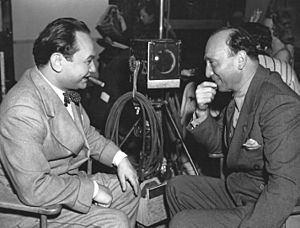
After James Cagney starred in Curtiz's Angels with Dirty Faces (1938), he was nominated for an Oscar for the first time. The New York Film Critics Circle voted him best actor for playing a hoodlum who changes his ways. Curtiz was also nominated again, which made him even more important to the studio. Curtiz was nominated for the 1938 Oscar for Best Director for both Angels with Dirty Faces and Four Daughters. He lost to Frank Capra.
The next year, Curtiz directed Sons of Liberty (1939). It starred Claude Rains and won an Oscar. This movie showed the Jewish contribution to America's independence. Curtiz also got great performances from Edward G. Robinson in Kid Galahad (1937). Robinson played a tough but kind boxing manager. The movie also starred Bette Davis and Humphrey Bogart.
Curtiz also directed three Westerns starring Flynn: Dodge City (1939), Santa Fe Trail (1940) with future U.S. president Ronald Reagan, and Virginia City (1940).
The 1940s: Golden Age Hits
The 1940s saw more highly praised films directed by Curtiz. These included The Sea Hawk (1940), Dive Bomber (1941), The Sea Wolf (1941), Casablanca (1942), Yankee Doodle Dandy (1942), This Is the Army (1943), Mildred Pierce (1945), and Life with Father (1947).
One of the biggest hits of 1940 was The Sea Hawk. It starred Errol Flynn as an adventurer like Sir Francis Drake. Flora Robson played Queen Elizabeth I, and Claude Rains played the Spanish ambassador. Some critics felt the story was like the real events happening in Europe at the time.
Dive Bomber (1941) was released a few months before the attack on Pearl Harbor. People liked the film, and it was the sixth-most popular movie that year. No other film before Pearl Harbor had such good flying scenes. Film writer Louella Parsons said, "Dive Bomber again makes us glad we are Americans protected by a Navy as competent as ours."
Filming at the active naval base in San Diego needed great care, especially for the flying scenes. Curtiz filmed Dive Bomber with Navy help and under strict Navy supervision. To make the shots realistic, he put cameras on Navy planes. This gave "amazing point-of-view shots," taking viewers inside the cockpit during flight. He also put cameras under the wings of planes to show take-offs from the Enterprise, an aircraft carrier.
With Michael Curtiz' magnificent 1941 version of The Sea Wolf ... full justice was for once done to London's text ... with the aid of models, newly introduced fog machines, and a studio tank, the film hauntingly captured an eerie malevolent atmosphere, brooding and full of terror ... From its economic opening scenes ... to its powerful climax ... it gripped consistently. Throughout, Curtiz provided object lessons in the use of sound—the groaning timbers of the ship, creaking footsteps, the wind—and closeups.
Hollywood in the Forties
Edward G. Robinson starred in The Sea Wolf (1941), his second film directed by Curtiz. He played a wild, bossy ship captain in a movie based on one of Jack London's best novels. Robinson said his character was "a Nazi in everything but name." This was important because of the world situation at that time. John Garfield and Ida Lupino played young lovers trying to escape the captain's harsh rule. Some reviews called the film one of Curtiz's "hidden gems."
Curtiz directed another Air Force film, Captains of the Clouds (1942), about the Royal Canadian Air Force. It starred James Cagney and Brenda Marshall. Its producer, Hal B. Wallis, said it was Warner Bros.' biggest and most difficult production. Everything had to be moved to Canada. Like Dive Bomber, its clear aerial scenes, filmed in Technicolor, got a lot of attention. The film was nominated for Best Art Direction and Best Color Cinematography.
Curtiz directed Casablanca (1942), a romantic drama set during World War II. Roger Ebert in 1996 called it one of the most popular films ever made. It starred Humphrey Bogart as an American living in Morocco, and Ingrid Bergman as a woman trying to escape the Nazis. The movie got eight Academy Award nominations and won three, including Best Director for Curtiz. Time magazine in 2012 called Casablanca "the best movie ever made."
Shortly after Captains of the Clouds was finished, but before Casablanca, Curtiz directed the musical movie Yankee Doodle Dandy (1942). This film was about singer, dancer, and composer George M. Cohan. It starred James Cagney in a role very different from the gangster he played in Curtiz's Angels with Dirty Faces. In this patriotic musical, Cagney showed his great dancing and singing skills. It was Cagney's favorite role.
Cagney's amazing performance earned him his only Academy Award for Best Actor. For Warner Bros., it was their biggest box-office success up to that time. It was nominated for nine Academy Awards and won four. The film's success was also a high point in Curtiz's career, with his nomination as Best Director. The film is now a classic, kept in the United States National Film Registry at the Library of Congress for being "culturally, historically, or aesthetically significant."
Another patriotic Curtiz film was This Is the Army (1943). It was a musical based on a stage play with music by Irving Berlin. As America was fighting in World War II, the film helped boost the spirits of soldiers and the public. Among its nineteen songs, Kate Smith's singing of "God Bless America" was a highlight. The film had many popular elements like combat, training, marching, comedy, romance, song, and dance. It was the most financially successful war-themed film made during World War II.
During this time, Curtiz also directed the World War II propaganda film Mission to Moscow (1943). This film was asked for by President Franklin D. Roosevelt. It supported the U.S. and British ally, the Soviet Union, which was fighting 80% of German forces at the time. The film was mostly well-received by critics and made money. However, it later became controversial because it caused strong feelings against communism. Curtiz took the criticism personally and promised never to direct a political film again, a promise he kept.
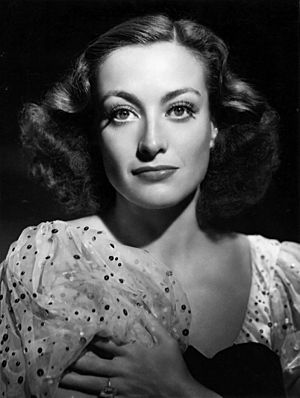
Mildred Pierce (1945) was based on a novel by James M. Cain. Its star, Joan Crawford, gave one of her best performances. She played a mother and successful businesswoman who gives up everything for her spoiled daughter, played by Ann Blyth.
When Crawford took the role, her 18-year career at MGM was slowing down. She had been one of Hollywood's biggest stars, but her films started losing money. By the late 1930s, she was called "box office poison." Instead of staying at MGM, she left and signed with Warner Bros. for less money.
Curtiz originally wanted Barbara Stanwyck for the role. However, Crawford, who hadn't been in a film for two years, tried hard to get the part. She was even willing to audition for Curtiz, which was rare for a big star. She knew that "Mr. Mike Curtiz hated me." He had said, "I don't want those big broad shoulders." But during her audition, as she read an emotional scene, he was so moved that he cried. He then said, "I love you, baby."
To help Crawford prepare for court scenes, Curtiz took her to visit jails and watch criminal trials. When filming her, he used careful film noir camera techniques, a style he learned in Europe. He used rich black-and-white lighting to highlight Crawford's face. He knew Crawford cared a lot about her image and quality. Crawford learned to appreciate Curtiz's skill with the camera. Eve Arden, who was nominated for Best Supporting Actress for the film, said Curtiz "knew what he wanted and was able to express himself exactly, even in his amusing Hungarian accent."
Mildred Pierce was nominated for six Academy Awards, including Best Picture. Only Crawford won, for Best Actress, her first and only Oscar. The novel's author, James M. Cain, gave her a special copy of the book. He wrote, "To Joan Crawford, who brought Mildred to life as I had always hoped she would be, and who has my lifelong gratitude." The film brought Crawford back to being a top star.
After the film's success, Jack Warner gave Curtiz two new, great contracts. His salary increased, and he only had to direct two films a year.
Curtiz directed William Powell and Irene Dunne in Life with Father (1947), a family comedy. It was a big hit in the United States and was nominated for four Academy Awards, including Best Actor for Powell. Powell acted in 97 films in his career; this was his third and last Oscar nomination. One review said, "He is magnificent in the role... His is one of the really great screen performances of the year."
In the late 1940s, Curtiz made a new deal with Warner Bros. The studio and his own production company would share the costs and profits of his future films. He said, "I'm going to try to build my own stock company and make stars of unknowns." He also said he cared more about an actor's personality than their looks. "If they are good-looking, that's something extra. But I look for personality."
He soon found that good stories were even harder to find. He complained that "Studios will pay anything for good stories... they will buy it up before anyone else can get it." The story for Life With Father reportedly cost the studio $300,000, and the total budget for the film was about $3 million. However, his later films didn't do as well. Curtiz himself said, "You are only appreciated so far as you carry the dough into the box office. They throw you into gutter next day."
The 1950s: Later Career
Curtiz's films continued to cover many types of stories, including biographies, comedies, and musicals. Some successful and well-liked films were Young Man with a Horn (1950), Jim Thorpe – All-American (1951), The Story of Will Rogers (1952), White Christmas (1954), We're No Angels (1955), and King Creole (1958).
Young Man with a Horn (1950) starred Kirk Douglas, Lauren Bacall, and Doris Day. Douglas played a jazz musician whose career rises and falls, based on the real-life cornet player Bix Beiderbecke. Curtiz directed another biography, Jim Thorpe – All-American (1951), starring Burt Lancaster. This film told the true story of a Native American athlete who won more gold medals than anyone else at the 1912 Summer Olympics in Stockholm. It was praised as one of the best sports movies.
Curtiz then directed I'll See You in My Dreams (1952), with Doris Day and Danny Thomas. This musical biography was about the songwriter Gus Kahn. It was Day's fourth film directed by Curtiz. He had first auditioned her and given her a starring role in her first movie, Romance on the High Seas (1948). She was surprised to be offered a lead role in her first film and told Curtiz she was a singer with no acting experience. Curtiz liked that "she was honest." He also thought "her freckles made her look like the All-American Girl." Day would be the discovery he was most proud of later in his career.
The Story of Will Rogers (1952) was also a biography. It told the story of the humorist and movie star Will Rogers, played by his son, Will Rogers Jr..
The long partnership between Curtiz and Warner Bros. eventually ended in a difficult court battle. After his relationship with Warner Bros. broke down, Curtiz continued to direct as a freelance director from 1954 onwards. He directed The Egyptian (1954) for Fox. It starred Jean Simmons, Victor Mature, and Gene Tierney. He directed many films for Paramount, including White Christmas, We're No Angels, and King Creole. White Christmas (1954), Curtiz's second movie based on an Irving Berlin musical, was a huge success. It was the highest-earning film of 1954. It starred Bing Crosby, Danny Kaye, Rosemary Clooney, and Vera-Ellen.
Curtiz directed The Scarlet Hour (1956), which starred new actors Carol Ohmart and Tom Tryon. It was said that Curtiz was difficult and didn't like the script. The film did not do well.
Another musical, King Creole (1958), starred Elvis Presley and Carolyn Jones. When asked to direct Presley, who was then the "king of rock and roll," Curtiz first laughed. He thought Presley wouldn't be able to act. But after talking with him, his opinion changed. Curtiz said, "I guarantee that he'll amaze everyone. He shows formidable talent." During filming, Presley was always the first one on set. When told what to do, no matter how strange or hard, he simply said, "You're the boss, Mr. Curtiz."
The script, music, and acting all came together to make a remarkable movie. Presley never made another film quite like it. It received good reviews. Variety magazine said the film "Shows the young star [Presley] as a better than fair actor." The New York Times also gave it a good review. Presley later thanked Curtiz for giving him the chance to show his acting skills. Of his 33 films, Elvis said King Creole was his favorite.
The last film Curtiz directed was The Comancheros, released six months before he died from cancer on April 10, 1962. Curtiz was sick during the filming. Star John Wayne took over directing on days Curtiz was too ill to work. Wayne did not want to be credited as a co-director.
Directing Style
Preparation and Vision
Curtiz always spent the necessary time preparing every part of a film before shooting. He said, "the chief work in directing a film is in preparing a story for the screen... Nothing is as important." He compared a director to a general leading an army. He believed the director should know what's coming and what to expect.
By spending time on preparation, he avoided delays once filming started. This allowed him to make about six films a year until the 1940s. He made Front Page Woman (1935) in only three weeks. This film had fast-paced newspaper dialogue with Bette Davis. Then he immediately made Captain Blood entirely on the sound stage without leaving the studio.
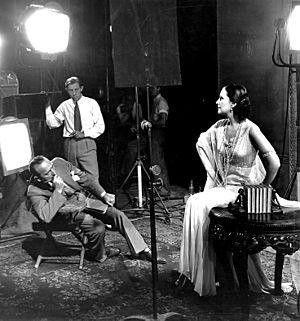
Film expert Sidney Rosenzweig says Curtiz had his own personal style by the time he moved to America. This included "high crane shots to show the setting; unusual camera angles and complex scenes where characters are often framed by objects; lots of camera movement; shots from a character's point of view; and high contrast lighting with dark shadows." Aljean Harmetz states that "Curtiz's vision of any movie... was almost totally a visual one."
A few months after arriving in Hollywood, Curtiz explained that he wanted viewers to feel like they were actually watching a story unfold on screen.
Curtiz liked to compare himself to an artist, painting with characters, light, motion, and background on a canvas. However, during his career, this "individualism," as Robertson says, "was hidden from public view." This was because Curtiz's films covered so many different types of stories. He was often seen as a skilled technician who worked for Warner Bros., rather than an artist with a unique style.
Hal B. Wallis, who produced many of Curtiz's films, including Robin Hood, always watched the budgets closely. He wrote to Jack Warner during the filming of Robin Hood: "In his excitement to make great shots and use the great production values in this picture, he is, of course, more likely to go too far than anyone else."
Curtiz himself rarely wrote about his ideas or filmmaking style. He was always too busy making films. So, there is no autobiography and only a few interviews. His brother said Curtiz was "shy, almost humble" in his private life, but "take-charge" at work. His brother added that "he did not want anybody to write a book about him." When Curtiz was once asked to describe his filmmaking philosophy, he said, "I put all the art into my pictures that I think the audience can stand."
Story Themes
Before coming to Hollywood, Curtiz always thought about the story first. The human side of a story was key, along with the plot developing as the film went on.
His attitude didn't change when he joined a big studio, even when he was given huge movies to direct. Even in the 1940s, he still preferred "homey pictures." He said it was "because I want to deal with human and basic problems of real people. That is the basis of all good drama." He believed this was true even in a big spectacle, where you must "never forget the underlying humanity and identity of your characters." However, he also felt that five different directors would make five different versions of the same story. "No two would be alike," he said, as each director's "work is reflection of himself."
Film historian Peter Wollen says that throughout Curtiz's career, his films showed characters who had to "deal with injustice, oppression, being trapped, being moved, and being exiled." He gives examples like 20,000 Years in Sing Sing (1932), which dealt with feeling alone in society. Films like Captain Blood, The Adventures of Robin Hood, and The Sea Hawk were all about a cruel ruler threatening people's freedom.
Personal Habits
Curtiz was always very active. He worked very long days, played several sports in his free time, and often slept under a cold shower. He skipped lunches because they interrupted his work and made him tired. He didn't like actors who ate lunch, believing they would have no energy in the afternoons.
Wallis said he was "a demon for work." He woke up at 5 am every day and usually stayed at the studio until 8 or 9 pm. Wallis said he hated to go home at the end of the day. With his high energy, he also paid attention to every small detail on the set.
To learn more about life in the U.S., since he rarely traveled outside Hollywood, he was always curious when he went on location shoots. Wallis observed that he explored everything:
He had a thirst for knowledge; he wanted to see the poolrooms, the flophouses, the Chinese sections, the slums—everything strange and exotic and seedy so that he could add to the knowledge that gave his pictures their amazing degree of realism.
His friends called him "Iron Mike" because he stayed physically fit. He played polo when he had time and owned horses at home. He said his fitness and energy came from living a sober life. Even with his great success and wealth, he didn't let himself "be fondled in the lap of luxury."
Working with Actors
The downside of his dedication was that he could be harsh. Many thought this was because of his Hungarian background. Fay Wray, who worked with Curtiz on Mystery of the Wax Museum, said, "I felt that he was not flesh and bones, that he was part of the steel of the camera." Curtiz was not popular with most of his colleagues, many of whom thought him arrogant. He didn't deny it, explaining, "When I see a lazy man or a don't care girl, it makes me tough. I am very critical of actors, but if I find a real actor, I am first to appreciate them."
Still, Bette Davis, who was not well known in 1932, made five more films with him. They often argued when filming The Cabin in the Cotton (1932), one of her earliest roles. He generally had a low opinion of actors. He said acting "is fifty percent a big bag of tricks. The other fifty percent should be talent and ability, although it seldom is." Overall, he got along well enough with his stars, which is shown by his ability to attract and keep some of Hollywood's best actors. He got along very well with Claude Rains, whom he directed in ten films.
Curtiz struggled with English because he was too busy filming to learn the language well. He sometimes used hand gestures to show actors what he wanted. This led to many funny stories about his choice of words. David Niven never forgot Curtiz saying "bring on the empty horses" when he meant "bring out the horses without riders." Niven even used this phrase for the title of his memoir. Similar stories are common: For the final scene in Casablanca, Curtiz asked the set designer for a "poodle" on the ground so the actors' wet steps could be seen. The next day, the set designer brought a small dog, not realizing Curtiz meant "puddle," not "poodle."
Personal Life
When he left for the United States, Curtiz had two children born outside of marriage. Around 1918, he married actress Lucy Doraine, and they divorced in 1923. He had a long relationship with Lili Damita starting in 1925. Some reports say they married, but film scholar Alan K. Rode says there is no proof of this.
Curtiz left Europe before the rise of Nazism. Other members of his family were not as lucky. In 1938, he asked Jack Warner, who was going to Budapest, to help his family get visas to leave. Warner succeeded in bringing Curtiz's mother to the U.S., where she lived with her son. However, he could not save Curtiz's only sister, her husband, or their three children. They were sent to Auschwitz, where her husband and two of the children were murdered.
Curtiz paid part of his own salary into the European Film Fund. This group helped European refugees in the film business settle in the U.S..
In 1933, Curtiz became a naturalized U.S. citizen. By the early 1940s, he was quite wealthy, earning $3,600 per week. He owned a large estate with a polo pitch. One of his regular polo partners was Hal B. Wallis, who became a close friend. Wallis's wife, actress Louise Fazenda, and Curtiz's third wife, Bess Meredyth, were close friends before Curtiz married Meredyth in 1929. Curtiz had many affairs. Meredyth left him for a short time once, but they remained married until 1961, when they separated. They stayed married until his death. She often helped Curtiz when his English wasn't enough to understand scripts or other things. He often called her for advice while filming.
Curtiz was the stepfather of movie and television director John Meredyth Lucas. Lucas talks about him in his autobiography Eighty Odd Years in Hollywood.
Death
Curtiz died from cancer on April 10, 1962, at age 75. At the time of his death, he was living alone in a small apartment in Sherman Oaks, California. He is buried in the Forest Lawn Memorial Park Cemetery in Glendale, California.
Legacy
Curtiz directed some of the most famous films of the 20th century. He helped many actors win awards for their performances. Before moving to Hollywood from Hungary at age 38, he had already directed 64 films in Europe. He quickly helped Warner Bros. become the fastest-growing studio in the country. He directed 102 films during his Hollywood career, more than any other director. Jack L. Warner, who first found Curtiz, called him "Warner Brothers' greatest director."
He directed 10 actors to Oscar nominations: Paul Muni, John Garfield, James Cagney, Walter Huston, Humphrey Bogart, Claude Rains, Joan Crawford, Ann Blyth, Eve Arden, and William Powell. Cagney and Crawford won their only Academy Awards under Curtiz's direction. Cagney later said on TV that part of his success was due to "the unforgettable Michael Curtiz." Curtiz himself was nominated five times and won Best Director for Casablanca.
He was known as a demanding boss to his actors. He controlled every detail on the set. With his experience as a director since 1912, his dedication to his art made him a perfectionist. He had an amazing control of technical details.
Some, like screenwriter Robert Rossen, wonder if Curtiz has been "misjudged by cinema history." He is not always included among directors like John Ford, Howard Hawks, Orson Welles, and Alfred Hitchcock. But he was "a talent highly aware of the creative movements of his time." These included German expressionism, the Hollywood studio system, types of films like film noir, and the possibilities of talented stars.
Film historian Catherine Portuges has called Curtiz one of the "most mysterious of film directors, and often underrated." Film expert Peter Wollen wanted "to bring back" Curtiz's good reputation. He noted that with his huge experience and drive, he "could get unexpected meanings from a script" through his direction of actors and camera work.
Academy Award Nominations
| Year | Award | Film | Result |
|---|---|---|---|
| 1935 | Best Director (as write-in candidate) | Captain Blood | John Ford – The Informer |
| 1938 | Best Director | Angels with Dirty Faces | Frank Capra – You Can't Take It with You |
| Best Director | Four Daughters | ||
| 1939 | Best Short Subject | Sons of Liberty | Won |
| 1942 | Best Director | Yankee Doodle Dandy | William Wyler – Mrs. Miniver |
| 1943 | Best Director | Casablanca | Won |
Curtiz also won an Academy Award for Best Short Subject (Two-reel) for Sons of Liberty.
Six of Curtiz's films were nominated for Best Picture: Captain Blood (1935), The Adventures of Robin Hood (1938), Four Daughters (1938), Yankee Doodle Dandy (1942), Casablanca (1943), and Mildred Pierce (1945). Of these, only Casablanca won Best Picture.
Academy Award-Winning Performances Directed by Curtiz
| Year | Performer | Film | Result | ||||
|---|---|---|---|---|---|---|---|
| Academy Award for Best Actor | |||||||
| 1935 | Paul Muni | Black Fury (write-in candidate) | Nominated | ||||
| 1938 | James Cagney | Angels with Dirty Faces | Nominated | ||||
| 1942 | James Cagney | Yankee Doodle Dandy | Won | ||||
| 1943 | Humphrey Bogart | Casablanca | Nominated | ||||
| 1947 | William Powell | Life with Father | Nominated | ||||
| Academy Award for Best Actress | |||||||
| 1945 | Joan Crawford | Mildred Pierce | Won | ||||
| Academy Award for Best Supporting Actor | |||||||
| 1938 | John Garfield | Four Daughters | Nominated | ||||
| 1942 | Walter Huston | Yankee Doodle Dandy | Nominated | ||||
| 1943 | Claude Rains | Casablanca | Nominated | ||||
| Academy Award for Best Supporting Actress | |||||||
| 1945 | Eve Arden | Mildred Pierce | Nominated | ||||
| 1945 | Ann Blyth | Mildred Pierce | Nominated | ||||
Musicals Directed by Curtiz
| Year | Title | Starring | Notes |
|---|---|---|---|
| 1942 | Yankee Doodle Dandy | James Cagney & Joan Leslie | |
| 1943 | This is the Army | George Murphy, Joan Leslie, & Ronald Reagan | An Irving Berlin Film |
| 1946 | Night and Day | Cary Grant, Alexis Smith, & Monty Woolley | |
| 1948 | Romance on the High Seas | Jack Carson, Doris Day, & Janis Paige | |
| 1950 | Young Man with a Horn | Kirk Douglass, Lauren Bacall, & Doris Day | |
| 1952 | The Jazz Singer | Danny Thomas & Peggy Lee | |
| 1954 | White Christmas | Bing Crosby, Danny Kaye, Rosemary Clooney, & Vera-Ellen | An Irving Berlin Film |
AFI Recognition
The American Film Institute ranked Casablanca #3 and Yankee Doodle Dandy #98 on its list of the greatest American movies. The Adventures of Robin Hood and Mildred Pierce were also considered for the list.
Selected Hollywood Films
- Tenderloin (1928)
- Noah's Ark (1928)
- The Mad Genius (1931) with John Barrymore and Marian Marsh
- The Cabin in the Cotton (1932) with Richard Barthelmess and Bette Davis
- Doctor X (1932) with Fay Wray and Lionel Atwill
- Goodbye Again (1933) with Warren William and Joan Blondell
- 20,000 Years in Sing Sing (1933) with Spencer Tracy and Bette Davis
- Mystery of the Wax Museum (1933) with Lionel Atwill, Fay Wray, and Glenda Farrell
- The Kennel Murder Case (1933) with William Powell as Philo Vance
- Jimmy the Gent (1934) with James Cagney and Bette Davis
- British Agent (1934) with Leslie Howard and Kay Francis
- Black Fury (1935)
- Front Page Woman (1935) with Bette Davis and George Brent
- Captain Blood (1935) with Errol Flynn and Olivia de Havilland
- Kid Galahad (1937) with Edward G. Robinson, Bette Davis and Humphrey Bogart
- The Adventures of Robin Hood (1938) with Errol Flynn, Olivia de Havilland and Basil Rathbone
- Four Daughters (1938) with John Garfield and Claude Rains
- Angels with Dirty Faces (1938) with James Cagney and Humphrey Bogart
- Dodge City (1939) with Errol Flynn and Bruce Cabot
- The Private Lives of Elizabeth and Essex (1939) with Bette Davis, Errol Flynn and Olivia de Havilland
- Santa Fe Trail (1940) with Errol Flynn, Olivia de Havilland and Ronald Reagan
- Virginia City (1940) with Errol Flynn and Randolph Scott
- The Sea Hawk (1940) with Errol Flynn and Alan Hale Sr.
- The Sea Wolf (1941) with Edward G. Robinson and John Garfield
- Dive Bomber (1941) with Fred MacMurray and Ralph Bellamy
- Captains of the Clouds (1942) with James Cagney and famed fighter pilot Billy Bishop
- Casablanca (1942) with Humphrey Bogart and Ingrid Bergman
- Yankee Doodle Dandy (1942) with James Cagney and Walter Huston
- Mission to Moscow (1943) with Walter Huston
- Mildred Pierce (1945) with Joan Crawford and Ann Blyth
- Night and Day (1946) with Cary Grant as Cole Porter
- Life with Father (1947) with William Powell, Irene Dunne and Elizabeth Taylor
- Romance on the High Seas (1948); Doris Day's movie debut
- The Breaking Point (1950) with John Garfield and Patricia Neal
- I'll See You in My Dreams (1951), a biographical film of composer and lyricist Gus Kahn, with Doris Day and Danny Thomas
- The Jazz Singer (1952), a remake with Danny Thomas and Peggy Lee
- White Christmas (1954) with Bing Crosby and Rosemary Clooney
- The Egyptian (1954) with Jean Simmons, Victor Mature and Gene Tierney
- We're No Angels (1955) with Humphrey Bogart and Peter Ustinov
- The Vagabond King (1956) with Oreste Kirkop, Kathryn Grayson and Rita Moreno
- The Proud Rebel (1958) with Allan Ladd and Olivia de Havilland
- King Creole (1958) with Elvis Presley and Walter Matthau
- The Adventures of Huckleberry Finn (1960) with Eddie Hodges, Tony Randall and Patty McCormack
- The Comancheros (1961) with John Wayne and Stuart Whitman
See also
 In Spanish: Michael Curtiz para niños
In Spanish: Michael Curtiz para niños


